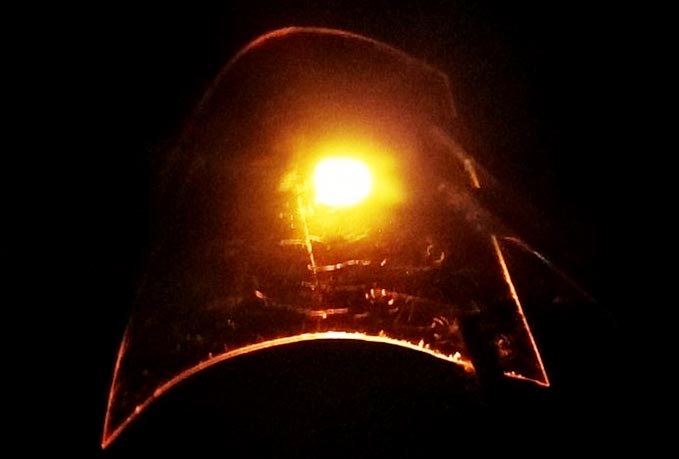A candlelight-like glow from a flexible organic LED

A bendable organic LED with a natural mica backing releases a strong, candlelight-like glow.
Credit: Andy Chen and Ambrose Chen
Giving off a comfortable glow, candles set the ambiance for a special dinner or just a quiet evening at home. However, some lighting alternatives, such as electronic candles, give off unwanted blue wavelengths that interfere with the body’s circadian rhythm. Now, researchers reporting in ACS Applied Electronic Materials have fabricated an improved bendable organic LED that releases candlelight-like light for flexible lighting and smart displays that people can comfortably use at night.
Previously, Jwo-Huei Jou and other researchers developed organic LEDs that released warm-white light, similar to that produced by candles. However, the devices still emitted some blue wavelength light, which can interfere with sleep because it dampens the body’s production of melatonin. These devices were made of solid materials and weren’t flexible. One option for making them bendable is to use a plastic backing, as has been done for other organic LEDs. But plastics don’t stand up well to repeated bending. Another option for the backing is mica — a natural mineral with extreme temperature tolerance that can be split into bendable, transparent sheets. So, Jou, Ying-Hao Chu and colleagues wanted to develop an even better organic LED and apply it to a mica backing, creating a bendable candle-like light with a long lifespan.
The researchers deposited a clear indium tin oxide film onto a transparent mica sheet as the LED’s anode, which could bend 50,000 times without breaking. Next, the team mixed the luminescent substance N,N’-dicarbazole-1,1’-biphenyl with red and yellow phosphorescent dyes to produce a light-emitting layer. This layer was then placed between electrically conductive solutions with the anode on one side and an aluminum layer on the other side, creating a flexible organic LED. When a constant current was applied to the device, it produced a bright, warm light with even less blue wavelength emissions than natural candlelight. Calculations showed that exposure to the LED for 1.5 hours would suppress a person’s melatonin production by about 1.6%, whereas light from a cold-white compact fluorescent lamp would suppress melatonin production by 29%. The researchers say that the flexibility of their candlelight-like organic LED opens up the design opportunities for blue-light-free nighttime devices.
The authors acknowledge funding from the Ministry of Science and Technology (Taiwan, Republic of China).
The American Chemical Society (ACS) is a nonprofit organization chartered by the U.S. Congress. ACS’ mission is to advance the broader chemistry enterprise and its practitioners for the benefit of Earth and all its people. The Society is a global leader in promoting excellence in science education and providing access to chemistry-related information and research through its multiple research solutions, peer-reviewed journals, scientific conferences, eBooks and weekly news periodical Chemical & Engineering News. ACS journals are among the most cited, most trusted and most read within the scientific literature; however, ACS itself does not conduct chemical research. As a leader in scientific information solutions, its CAS division partners with global innovators to accelerate breakthroughs by curating, connecting and analyzing the world’s scientific knowledge. ACS’ main offices are in Washington, D.C., and Columbus, Ohio.
To automatically receive news releases from the American Chemical Society, contact newsroom@acs.org.
Journal: ACS Applied Electronic Materials
DOI: 10.1021/acsaelm.2c00123
Article Title: Flexible Candlelight Organic LED on Mica
Article Publication Date: 9-May-2022
Media Contact
Katie Cottingham
American Chemical Society
k_cottingham@acs.org
Office: 301-775-8455
All latest news from the category: Materials Sciences
Materials management deals with the research, development, manufacturing and processing of raw and industrial materials. Key aspects here are biological and medical issues, which play an increasingly important role in this field.
innovations-report offers in-depth articles related to the development and application of materials and the structure and properties of new materials.
Newest articles

Innovative 3D printed scaffolds offer new hope for bone healing
Researchers at the Institute for Bioengineering of Catalonia have developed novel 3D printed PLA-CaP scaffolds that promote blood vessel formation, ensuring better healing and regeneration of bone tissue. Bone is…

The surprising role of gut infection in Alzheimer’s disease
ASU- and Banner Alzheimer’s Institute-led study implicates link between a common virus and the disease, which travels from the gut to the brain and may be a target for antiviral…

Molecular gardening: New enzymes discovered for protein modification pruning
How deubiquitinases USP53 and USP54 cleave long polyubiquitin chains and how the former is linked to liver disease in children. Deubiquitinases (DUBs) are enzymes used by cells to trim protein…



